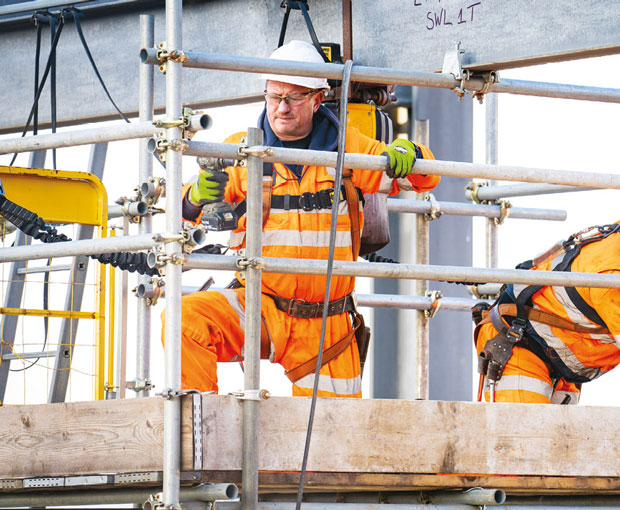ACHIEVING NET ZERO
He is also keen to debunk the theory that the only way to achieve net zero is to invest in the latest kit. Instead he advocates getting as much information as you can on your energy usage, and have a clear strategy of the insights you can get from the data.
He points out that any building for the last 30 years that has a demand of above 100kW must provide half hourly metering, so if you can get the half hourly data for your building you can begin to build a profile.
“For instance, if the building is occupied between 9 and 5, yet 75 per cent of the energy consumed is irrespective of whether people are in the building or not, what’s going on? That leads you to walk around the building at night to check what is running.
“This is energy 101 stuff, without even getting into having lots of data streams from bits of kit. You can do this and for example discover that an air handling unit runs at night time because three years ago there was an evening event and it’s been left on manual then and it’s still on manual now.
“I can also guarantee that the 80/20 rule applies to the whole estate, i.e. 80 per cent of your consumption is made by the biggest buildings. The question then goes to the building with a horrendous metric and while a lot of people might suggest ‘let’s put in solar panels,’ the first thing is actually to understand when the control system in the building was reviewed to see if it reflects the occupation of that building.
“That brings me to the subject of the energy hierarchy because, to paraphrase my old boss, if everything is leaking through the walls the last thing to worry about is solar panels. So there’s a whole pecking order you need to go through before you make any major investments.”
Within the FM sector we’re all too aware that some suppliers make their money by selling an FM contract on cost and making the money on major projects, some of which aren’t worth the effort. Singh’s view is that: “the industry is built on long term relationships and when you’re working on a client premises as a dedicated resource you are more the client and less so the FM.
“If the client comes and asks what’s the right thing to do we give them the best advice on what to do in the long run.”
As an example, in 2022, an EMCOR UK project team began a major project with Woking Borough Council to help improve its energy and carbon performance. Woking, which had a 17-storey city centre building heated by two 20-year old gas-fired boilers were interested in switching to a district heating and cooling network within the area that was certified as zero carbon.
Explains Singh: “Unfortunately, the infrastructure in the building meant it wouldn’t be possible to feed that low-grade heat into the building at the required level. We proposed installing two 400kW heat pumps that could raise the heat level to ensure the building could operate without an upgrade to the whole structure.”
The heat pump solution enabled them to secure Government funding for heat decarbonisation while delivering an efficient heating supply that now provides zero carbon heat for the entire building.
SMART BUILDING TECH
In recent years it often seems the path to achieving net zero is to invest in Smart Building tech, but again like sustainability Singh believes there’s a danger that people will conflate its meaning.
“Some think Smart Building tech is when you scan your pass at the front door and your desk light comes on, but to me as an engineer it is a pump with a vibration sensor that alerts me when the pump is about to fail. This gives me the insight to know I’ve got an opportunity here to avoid any disruption to the building and rather than have a last-minute panic and replace like for like, take the opportunity to find a more efficient replacement.”
He also argues that in a post pandemic world, with buildings which are 80 per cent occupied on a Wednesday, 50 per cent on a Tuesday and Thursday, 30 per cent on a Monday and 20 per cent on a Friday, air handling units may still operate at full capacity all week. By installing CO2 sensors’ that measure the number of people in the building at any time, you can maintain indoor air quality standards and improve energy efficiency.
Says Singh: “Using the data I can have a control strategy in the BMS that drives the air handling unit according to the number of people that are in the building.
“As FMs that is what we should be aiming to introduce. Smart building technologies that allow us to be much more data driven, both from a maintenance and operational perspective as opposed to just bells and whistles.”
Another proposed option for achieving net zero is to move into the most modern green buildings, but for Singh’s team it’s only in cases where a client needs to consolidate their real estate space that would prompt them to suggest an office move.
“A stay or go conversation is not simply based on one area but a decision based on which is the most carbon intensive assets, and the worst performing plant and least served by public transport.
“Other than that, moving buildings is a piece of advice we rarely give because we tend to find we’re going to have to work with what we’ve got. This usually means going through that same process I’ve listed previously, ‘let’s make it work in the most optimal way as it stands and then do a shopping list of ways of improving it’.
“We approach it from a pragmatic building operational perspective, because while the big automation companies may tell us about Smart building innovations, most of them are not applicable to 80 per cent of buildings.
“However, I am absolutely for Smart buildings as it applies to the next iteration of a BMS, as these should do much more than just turn your boiler on and off.
“A lot of this is about simplifying the process. Some clients are completely bamboozled and think it’s so complicated and steeped in layers of complexity. My challenge to every energy management supplier is that this is not complicated and if you say to a new client, ‘give us a bit of time looking at your estate we will come back and tell you what net zero means to you’.
“It’s as easy as that.”
For details on the session at EMEX visit: www.emexlondon.com/conference-programme-1/businesses-reduce-energy-costs





